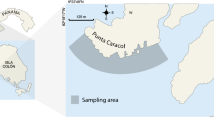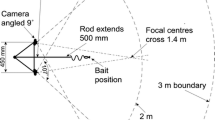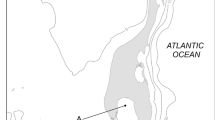Abstract
Animals in social aggregations often spend more time foraging than solitary conspecifics. This may be a product of the relative safety afforded by aggregations: group members can devote more time to foraging and less time to antipredator behaviors than solitary animals (the “risk reduction” effect). All else being equal, risk reduction should result in higher food intake for grouped animals. However, intragroup competition may force group members to spend more time foraging in order to obtain the same food ration as solitary individuals (the “resource competition” effect). We compared these opposing explanations of foraging time allocation in a coral reef fish, bluehead wrasse (Thalassoma bifasciatum). Aggregations of juvenile bluehead wrasse experience safety-in-numbers, and preliminary observations suggested that juveniles in aggregations spent more time foraging for copepods in the water column than solitary juveniles. However, the risk reduction and resource competition hypotheses are indistinguishable on the basis of behavioral observations alone. Therefore, we collected behavioral, dietary, and growth data (using otolith growth rings) for bluehead wrasse at multiple reefs around a Caribbean island. Despite spending more time foraging in the water column, grouped fish did not capture more prey items and had slower growth rates than solitary fish. Thus, the increased foraging time of grouped fish appears to reflect resource competition, not risk reduction. This competition may limit the size and frequency of aggregations among juvenile bluehead wrasse, which have been shown to experience reduced mortality rates in larger groups. Bluehead wrasse recruits also spent less time foraging but grew faster at sites where planktonic copepod prey were more abundant. This suggests the possibility that large-scale spatiotemporal variability in the abundance of planktonic copepods over coral reefs may produce corresponding variability in the dynamics of reef fish populations.




Similar content being viewed by others
References
Barbosa A (2003) Group size effects on vigilance: we need more bricks in the wall. Behav Processes 63:133–134
Beauchamp G (2003) Group-size effecs on vigilance: a search for mechanisms. Behav Processes 63:111–121
Bednekoff PA (2003) Testing explanations of the group size effect on vigilance: let’s be direct. Behav Processes 63:135–136
Bednekoff PA, Lima SL (1998) Randomness, chaos and confusion in the study of antipredator vigilance. Trends Ecol Evol 13:284–287
Booth DJ (1992) Larval settlement patterns and preferences by domino damselfish Dascyllus albisella Gill. J Exp Mar Biol Ecol 155:85–104
Booth DJ (1995) Juvenile groups in a coral-reef damselfish: density-dependent effects on individual fitness and population demography. Ecology 76:91–106
Booth DJ (2004) Synergistic effects of conspecifics and food on growth and energy allocation of a damselfish. Ecology 85:2881–2887
Booth DJ, Beretta GA (2004) Influence of recruit condition on food competition and predation risk in a coral reef fish. Oecologia 140:289–294
Brown JS, Laundre JW, Gurung M (1999) The ecology of fear: optimal foraging, game theory and trophic interactions. J Mammal 80:385–399
Buckel JA, Stoner AW (2004) Negative effects of increasing group size on foraging in two estuarine piscivores. J Exp Mar Biol Ecol 307:183–196
Caselle JE, Warner RR (1996) Variability in recruitment of coral reef fishes: the importance of habitat at two spatial scales. Ecology 77:2488–2504
Caselle JE, Hamilton SL, Warner RR (2003) The interaction of retention, recruitment, and density-dependent mortality in the spatial placement of marine reserves. Gulf Carib Res 14:107–118
Chisholm LA, Roff JC (1990) Size-weight relationships and biomass of tropical neritic copepods off Kingston, Jamaica. Mar Biol 106:71–77
Clarke RD (1999) Diets and metabolic rates of four Caribbean tube blennies, genus Acanthemblemaria (Teleostei: Chaenopsidae). Bull Mar Sci 65:185–199
Clark CW, Mangel M (1986) The evolutionary advantages of group foraging. Theor Popul Biol 30:45–75
Clifton KE (1991) Subordinate group members act as food-finders within striped parrotfish territories. J Exp Mar Biol Ecol 145:141–148
Connell SD, Gillanders BM (1997) Mortality and abundance of a schooling reef fish. Proc Eighth Int Coral Reef Symp 1:1035–1038
Courchamp F, Clutton-Brock T, Grenfell BT (1999) Inverse density dependence and the Allee effect. Trends Ecol Evol 14:405–410
Eckert GJ (1987) Estimates of adult and juvenile mortality for labrid fishes at One Tree Reef, Great Barrier Reef. Mar Biol 95:167–171
Forrester GE (1990) Factors influencing the juvenile demography of a coral reef fish. Ecology 71:1666–1681
Gascoigne JC, Lipcius RN (2004) Allee effects in marine systems. Mar Ecol Prog Ser 269:49–59
Grand TC, Dill LM (1999) The effect of group size on the foraging behavior of juvenile coho salmon: reduction of predation risk or increased competition? Anim Behav 58:443–451
Hartney KB (1989) The foraging ecology of two sympatric gobiid fishes: importance of behavior in prey type selection. Environ Biol Fishes 26:105–118
Hixon MA, Webster MS (2002) Density dependence in marine fishes: coral-reef populations as model systems. In: Sale PF (ed) Coral reef fishes: dynamics and diversity in a complex ecosystem. Academic Press, San Diego, Calif., pp 303–325
Holbrook SJ, Schmitt RJ (1988) The combined effects of predation risk and food reward on patch selection. Ecology 69:125–134
Holbrook SJ, Schmitt RJ (2002) Competition for shelter space causes density-dependent predation mortality in damselfishes. Ecology 83:2855–2868
Johnsson JI (2003) Group size influences foraging effort independent of predation risk: an experimental study on rainbow trout. J Fish Biol 63:863–870
Jones GP (1987) Competitive interactions among adults and juveniles in a coral reef fish. Ecology 68:1534–1547
Lima SL (1998) Nonlethal effects in the ecology of predator–prey interactions. BioScience 48:25–35
Lima SL, Dill LM (1990) Behavioral decisions made under the risk of predation: a review and prospectus. Can J Zool 68:619–640
Magurran AE (1990) The adaptive significance of schooling as an anti-predator defence in fish. Ann Zool Fenn 27:51–66
Magurran AE, Pitcher TJ (1983) Foraging, timidity and shoal size in minnows and goldfish. Behav Ecol Sociobiol 12:147–152
Magurran AE, Pitcher TJ (1987) Provenance, shoal size and the sociobiology of predator-evasion behaviour in minnow shoals. Proc R Soc B 229:439–465
Mesa MG, Poe TP, Gadomski DM, Petersen JH (1994) Are all prey created equal? A review and synthesis of differential predation on prey in substandard condition. J Fish Biol 45:81–96
Montgomery DC, Peck EA, Vining GG (2001) Introduction to linear regression analysis, 3rd edn. Wiley, New York
Morgan IE, Kramer DL (2004) The social organization of adult blue tangs, Acanthurus coeruleus, on a fringing reef, Barbados, West Indies. Environ Biol Fishes 71:261–273
Motro R, Ayalon I, Genin A (2005) Near-bottom depletion of zooplankton over coral reefs. III. vertical gradient of predation pressure. Coral Reefs 24:95–98
Parrish JK, Edelstein-Keshet L (1999) Complexity, pattern, and evolutionary trade-offs in animal aggregation. Science 284:99–101
Pitcher TJ, Parrish JK (1993) Functions of shoaling behaviour in teleosts. In: Pitcher TJ (ed) Behaviour of teleost fishes, 2nd edn. Chapman & Hall, London, pp 363–440
Pitcher TJ, Magurran AE, Winfield IJ (1982) Fish in larger shoals find food faster. Behav Ecol Sociobiol 10:149–151
Sackley PG, Kaufman LS (1996) Effect of predation on foraging height in a planktivorous coral reef fish, Chromis nitida. Copeia 1996:726–729
Satapoomin S (1999) Carbon content of some common tropical Andaman Sea copepods. J Plankton Res 21:2117–2123
Searcy SP, Sponaugle S (2001) Selective mortality during the larval-juvenile transition in two coral reef fishes. Ecology 82:2452–2470
Sogard SM (1997) Size-selective mortality in the juvenile stage of teleost fishes: a review. Bull Mar Sci 60:1129–1157
Stephens DW, Krebs JR (1986) Foraging Theory. Princeton University Press, Princeton, N.J.
Thorrold SR, Hare JA (2002) Otolith applications in reef fish ecology. In: Sale PF (ed) Coral reef fishes: dynamics and diversity in a complex ecosystem. Academic Press, San Diego, Calif., pp 243–264
Victor BC (1982) Daily otolith increments and recruitment in two coral-reef wrasses, Thalassoma bifasciatum and Halichoeres bivittatus. Mar Biol 71:203–208
Victor BC (1986) Larval settlement and juvenile mortality in a recruitment-limited coral reef fish population. Ecol Monogr 56:145–160
Weatherley AH (1972) Growth and ecology of fish populations. Academic Press, London
Werner EE, Anholt BR (1993) Ecological consequences of the trade-off between growth and mortality mediated by foraging activity. Am Nat 142:242–272
White JW (2007) Spatially correlated recruitment of a marine predator and its prey shapes the large-scale pattern of density-dependent prey mortality. Ecol Lett (in press)
White JW, Warner RR (2007) Safety in numbers and the spatial scaling of density dependence in a coral reef fish. Ecology (in press)
Wolf NG (1987) Schooling tendency and foraging benefit in the ocean surgeonfish. Behav Ecol Sociobiol 21:59–63
Yund PO, Gaines SD, Bertness MD (1991) Cylindrical tube traps for larval sampling. Limnol Oceanogr 36:1167–1177
Acknowledgements
We thank J. Barr, S. Brander, J. M. Ecker, and C. Grigsby for expert assistance in the field. J. Godwin, E. Marsh, P. Munday, and St Croix Ultimate Bluewater Adventures provided invaluable logistical support. S. Hamilton and J. Samhouri kindly provided instruction in otolith analysis and, with S. Sandin, plankton tube traps. We are grateful to K. Klose and S. Cooper for providing equipment and assistance with plankton and benthos analysis. Ideas and comments from D. Booth, S. Brander, L. Dill, S. Hamilton, D. Kramer, the Sih lab group, and especially S. Gaines and S. Holbrook greatly improved this work and the manuscript. J. W. W. was supported by National Science Foundation Predoctoral and University of California Regents fellowships. This is contribution 260 from the Partnership for Interdisciplinary Studies of Coastal Oceans, funded primarily by the Gordon and Betty Moore Foundation and the David and Lucile Packard Foundation. This work complied with the current laws of the United States Virgin Islands (USVI); all fieldwork was performed in accordance with University of California Santa Barbara Institutional Animal Care and Use Committee permit no. 4-04-403 and USVI Department of Planning and Natural Resources permit nos. STX-024-04 and STX-025-05.
Author information
Authors and Affiliations
Corresponding author
Additional information
Communicated by Marc Mangel.
Electronic supplementary material
Rights and permissions
About this article
Cite this article
White, J.W., Warner, R.R. Behavioral and energetic costs of group membership in a coral reef fish. Oecologia 154, 423–433 (2007). https://doi.org/10.1007/s00442-007-0838-4
Received:
Revised:
Accepted:
Published:
Issue Date:
DOI: https://doi.org/10.1007/s00442-007-0838-4




